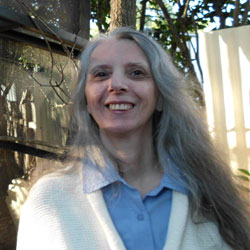In the International Pavilion,
for carven cats there are three positions
mainly: the sleeping round, the sphinx
and the sitting upright Bast,
protector of women. These cats
are painted in African sunset
colours, from bird pink to black,
with russets, grapes, and tangerines.
They look edgy, like the live
exhibits. The Show is always
edgy, its moon often a high
cold full Easter moon. Some of the
animals will die and be tasted
and fear it. Some schoolchildren
who bred them will vomit with pride.
Katharine and I avoid
the live exhibits these days, even
the pretty petting zoo. We buy a small pride
of soapstone for her cat collection, two
hippos for my soapstone hippos,
too. These hippos are different:
curled asleep like cats, not upright
on four legs with flaring noses.
When Katharine was a baby, I wrote
a poem that cats have small dry
noses and dogs large wet ones. Mysteriously,
it was requested for an erotic
international anthology and I agreed
diplomatically. Katharine still
finds that hilarious, but I suppose
the anthologists could have been northern
from some area of ice where noses
chill easily and need a pridelike welcome.
I try to photograph her with the new
digital camera but it has too
funhouse a dimension, distorts
the nose too far before the face, which
should suit the Show, but I abandon
it for the mobile phone, which shows
that moon of equinox behind her better, and
her small fine straight nose with its
slight nostril flare in proportion.
We buy a round white cloth cat:
mouthless, Japanese and strong,
the lack of mouth suggesting not
docility but a placid and wide
powerful telepathy. It has
a nose, which looks sensitive and neat.
Such cats were strewn around
the Japanese tidal wave wreckage, wet
and no doubt radioactive. Urbane men
with grim in their name and tone spoke
on Western TV saying that
the Japanese crisis would prove
the safety of nuclear power. Stray
toy cats without mouths did not
lower their pride to reply. The grim moon
of April is a pale pear blossom, not
pink like cherry, peach, or plum. Somewhere
here a cow lows, uncertain. We
hope it is a dairy cow, move on
in the milk-warm moon of caution.
Notes on the Poem
Jennifer Maiden's Liquid Nitrogen overflows with dense, intense, immense poems, crammed with hyper-informed perspectives on international politics and history. The poem "In the International Pavilion" is a great example of how she tempers her deluges of searing insights and diatribes with humour and personal connection. In their citation, the 2013 Griffin Poetry Prize judges zero in how Maiden achieves this superb balancing act: "An extended meditation on the uses and abuses of power, the moral gravity of Liquid Nitrogen is buoyed throughout by Maiden’s self-effacing sense of humor and her tenderness towards her grown daughter, Katharine, who stands at the heart of this collection." Katharine's appearances in this poem lend a measure of familiarity to this poem that draws us readers in. As Maiden juxtaposes the animal noses that have appeared in her poems (poems that have then appeared in surprising places, to her and her daughter's amusement) with observations about her daughter's own nose, we're assumed to share both the joke and the fond intimacy. Maiden's subtle humour seems to be an extension of the gentle and whimsical interplay she lets us see between her and her daughter: "We buy a round white cloth cat: mouthless, Japanese and strong, the lack of mouth suggesting not docility but a placid and wide powerful telepathy." yet it drives home piercing commentary: "Urbane men with grim in their name and tone spoke on Western TV saying that the Japanese crisis would prove the safety of nuclear power. Stray toy cats without mouths did not lower their pride to reply." ... which in turn adds both profundity and human scale to her passion for understanding the state of the world, and for surviving its turmoil with a cherished loved one at her side.
